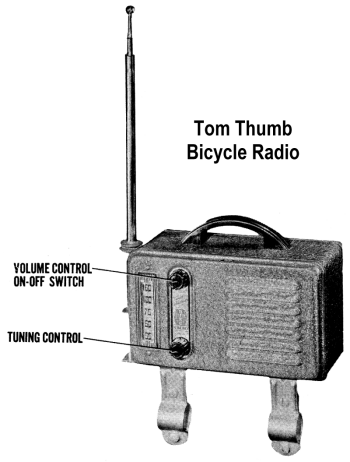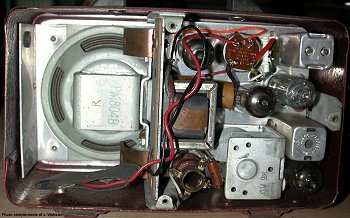|





























|
 |


Bicycle Radios
"With a tube on the handles and a loop on his bike
He'll have radio concerts where'ere he shall hike."
|

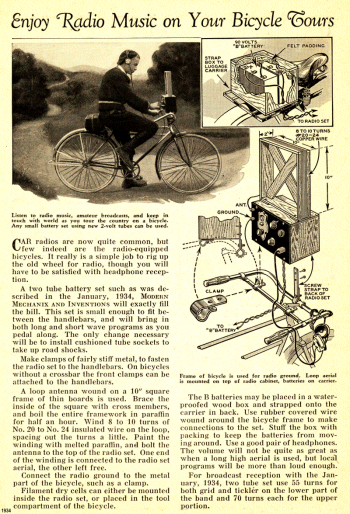 Larger Image
Larger Image |
 |
- Bicycle Radio History -
Bicycles predated consumer radios by at least 50 years but as soon as radios and their battery cases became physically small enough
to mount on a bicycle, many attempts were made and a few were even documented in newspapers and magazines.
The magazine article at left from 1934 details mounting a early vacuum tube radio along with it's batteries on a bicycle and
instructions for constructing and mounting a loop antenna on top of the radio. Notice the radio chosen is not large
enough to power a speaker and headphones would need to be worn by the rider. Read an earlier article from the 1920s here.
It wouldn't be until just before World War II that a radio designed by Motorola
specifically for bicycles would appear in radio stores and bicycle shops.
After World War II the vacuum tube bicycle radios manufactured offered smaller battery packs or had the batteries installed inside the radio case.
By the later 1950s transistors were replacing vacuum tubes in bike radios and in addition to smaller sizes, features like internal ferrite antennas, integrated headlights and horns began to appear.
Today's bike radios can fit in the palm of your hand, play your digital music collection and can have built in GPS giving you maps,
your location. speed, direction, altitude, and more.
|
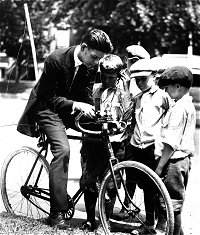
|

|
The picture at left is a 1922 archived photo of Francis Murray in Washington D.C. with a one tube radio and loop antenna he built and mounted on his bicycle. The back of the photo
gives details and is worth a look.
"With a tube on the handles and a loop on his bike
He'll have radio concerts where'ere he shall hike."
Larger Photo
Back with information
|

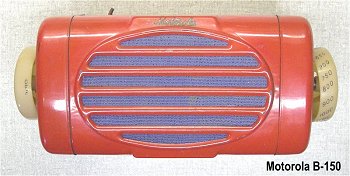
Motorola B-150 Bicycle Radio - 1940
In the late 1930s Motorola was commissioned to build radios that could be mounted on policeman's bicycles.
These were tuned specifically for picking up broadcasts on a predetermined police frequency.
Expanding on this idea, Motorola in 1939 introduced the model B-150 bicycle radio. The B-150 could tune in the entire broadcast
band (AM) and was marketed to the general public through both radio shops and bicycle stores.
The Motorola B-150 was a three vacuum tube radio with a separate battery pack. The battery pack was designed to clamp to the down
tube of the bicycle and the whip antenna could be bent forward and clipped to the front fender. The radio was bright red with blue speaker grill cloth.
The B-150 chassis in my collection shown here has been recapped.
Larger Photo
Chassis - Top
Chassis - Bottom
Brackets and Fender Clip
Factory Schematic (PDF File)
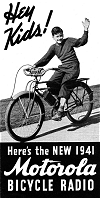 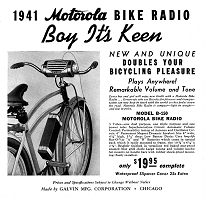
|  |
|  |
1940 advertisement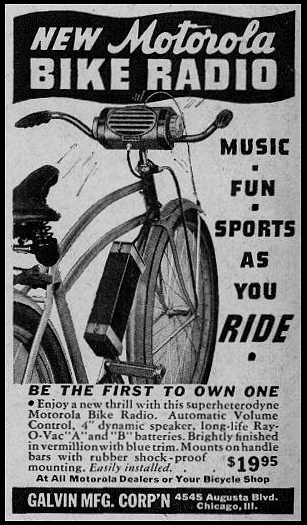
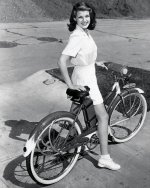
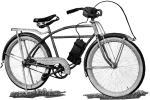
Rita Hayworth & B150
Radio Bike Contest Ad
|


Darb Holiday Bicycle radio
The Darb Holiday Bicycle radio was manufactured in the
mid 1950s by the S. C. Ryan Co., Minneapolis Minnesota.
The Darb bicycle radio was available in at least three colors, red, blue, and green. It used four vacuum tubes and came with a detachable battery pack that
clipped to the bottom of the radio or as an option, used a set of wired brackets to mount the radio on the handlebars and the
battery pack on the rear carrier. There was also an AC power supply available to replace the battery pack when the radio was used indoors.
The Darb used some rather unique off the shelf parts in it's construction.
More Information, Photos, and Service Manual
|  |
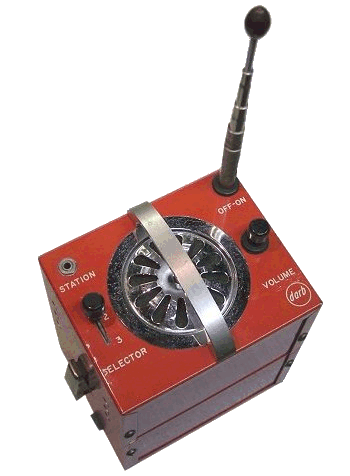
|

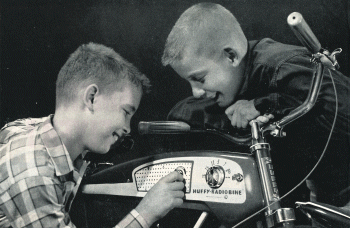 |
 |
The Huffy Radio Bike - 1955, 1956
The Huffy Radio Bike Was manufactured in 1955 and 1956. It had a radio built into the tank with a battery pack on the rear carrier. It was available in red, blue, and green.
I would guess that red was the most popular color as most that have survived are red.

Huffy Radio Bike Information:
More photos, schematic, and history
|

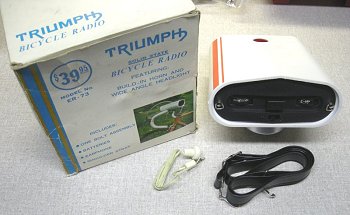 |
 |
Transistor Bicycle Radios
By the 1960s transistors had replaced vacuum tubes in bicycle radios. Batteries lasted longer (if you remembered to turn it off), and horns and lights were added.

Triumph transistorized bicycle radio (left) contained a radio, horn, and light. It came with a strap and quick disconnect bracket so you could take it with you.
It was powered by two D batteries for the horn and light and a nine volt battery for the radio.
Larger Photo Inside Photo Controls Light
|

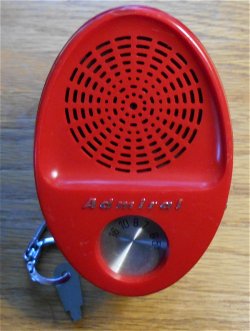 |
 |
Admiral PR280R AM Bicycle Radio
The Admiral PR280R Bicycle Radio is about four and a half inches tall. It's removable from the handlebar clamp and can be carried by the built in keychain that has a key for snapping the radio on and off the bike clamp.
There is an on/off volume control on the top and the station selector on the bottom. It's powered by a single 9 volt battery.
This one is red but I'm betting they came in different colors.
Admiral transistor radio chassis number 6B6.
Larger Photo
Side Photo
|

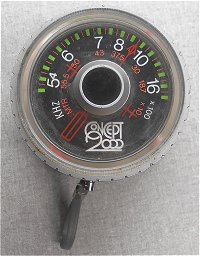 |
 |
Concept 2000 AM Bicycle Radio
The Concept 2000 Bicycle Radio is 3¼ inches tall. It is removable from the handlebar clamp and can be carried by the built in strap.
There is an on/off volume control on the side and the dial is on the face. It's designed to look like a spedometer and is powered by a single 9 volt battery.
Larger Photo
Side Photo
Box Face
|

 |
 |
Westinghouse RPA5030B Bicycle Radio/Headlight
This Westinghouse RPA5030B Bicycle AM Radio/Headlight is eight inches long. The On-Off-Volume control and AM station selector are on the back.
The radio is powered by a 9 volt battery and the headlight is powered by two C batteries. The speaker is on the bottom.
Larger Photo
Radio Controls
|

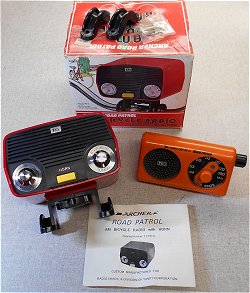 |
 |
Archer Road Patrol Bicycle radios
Archer Road Patrol Bicycle radios
Sold by every Radio Shack store, these were by far the most popular bicycle radios. The larger red Road Patrol Radio (catalog # 12-197A) is the most common and is a combination AM radio and horn powered by 4 "C" size batteries.
The smaller orange Road Patrol AM Radio is powered by a single 9 volt battery.
Larger Photo
Road Patrol Instructions and Schematic
|

|
|









